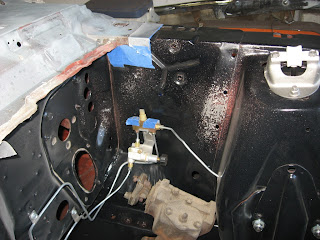Happy New Year! Sure, I'm over a month late with that but this is the first blog entry since last November. This weekend was the epidomy of productivity. I took down the Christmas lights, I did my taxes, watched a pretty exciting Super Bowl, and I worked on Ol' Rusty. All in the balmy goodness of 55 degrees and sunshine which is really saying something for Oregon in February.
Let's see now. When we left off, I had primed the rear quarters and cleaned up under the dash so that the car looked something like this:
I began by scuffing and grinding the surfaces of the dash, windshield trim, outer cowl panels, cowl top, and outer rockers. Each got a treatment of Ospho followed up by the usual neutralize, rinse, scuff, and degrease. I then masked off the engine compartment, loaded up the spray gun with DP40LF. The resulting effort looked like this:
A frontal view:
And the dash:
The rear seat panel still needed some work as this photo attests:
I fired up the angle grinder and knotted wire wheel and cleaned up the rear seat panel. I then noticed how shabby the DP74LF on the floor pans was starting to look with areas that the media blaster knocked the primer off as well as scuffs, and scratches from general knocking around.
I removed the masking tape and other debris from the floor pans and trunk floor, washed and then degreased the red oxide colored floor pans until they were ready to take a new coat of primer:
I loaded up the spray gun again, but with DP74LF this time, and resprayed the floors yet again. Okay, I'm not proud of the transition line between the red and the gray in the trunk but it's not going to be seen after paint which begs the question, why didn't I just paint it gray? I don't know, I'm just neurotic I guess.
So, it looks like I'm all done with the priming and general cleanup of the main shell at this point and it's probably okay to get her ready for paint. No, wait... I'm forgetting something. Something that I... need... to... do... The Weld & Sealant manual provides a subtle hint.
Awwww.... right. Seam sealer! I went down to NAPA to pick up a tube of my favorite sealer but how does that song go, "You don't always get what you waaant". They had one sad tube of sealer in stock. One tube of 3M All-Around Autobody Sealer. I thought to myself, "Well, it says 'all-around' so it must okay". I took it home, opened it up, and set to work. Ugh! WHITE! Not to be hampered by something so simple as a tube of seam sealer I told myself, "Self, I don't have a choice here, I need to do this today and it'll be covered up with paint", so off to work I went, putting down a bead, spreading it with an acid brush soaked in lacquer thinner, and so on and so forth:
The door jambs:
Along the top seam and in the drain channel seams:
And finally, around the tail panel.

Now the problem with this sealer is this, and I didn't realize it until the next day; This stuff isn't self-leveling (meaning it doesn't sag) or smooth out the brush strokes so it remains exactly as I put it on. Rough little edges sticking up here and there, brush strokes, etc. Plus it doesn't cure as firm as the NAPA brand I'd used before. I could easily peel it away with a thumb nail. Now, honestly, this is okay for areas that won't be painted and/or abused but for areas that are visible like the door jambs and the seams of the deck lid filler panel, I don't think it's such a good idea. I think I'll be scraping this off of those areas and reapplying a firmer sealer and paying better attention to neatness. However, this white sealer, being non-sagging, might work to simulate a more concourse look for that original "bulk sealer" that I easily scraped and chipped away from the interior joints and seams as it seems to hold it's shape up until it cures. Theoretically, you could glob it on just like the factory did and maybe tint it whatever color to give that concourse look. Just a thought.
Finally, I had some of the black firm sealer left over that I saved for use on the cowl-to-firewall seams under the dash:

So, all in all, not a bad weekend. Although I'll have to do some sealing over again, I can't think of a better way to spend a rare 55 degree day in February.


































